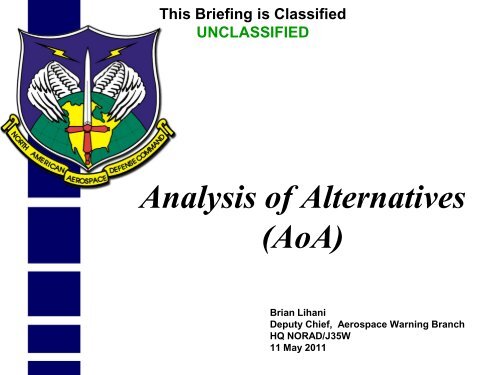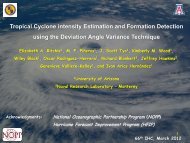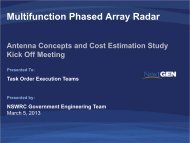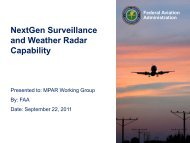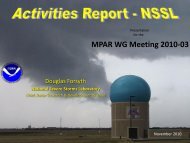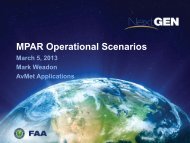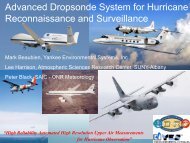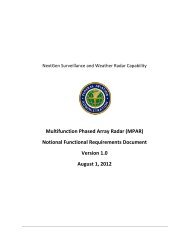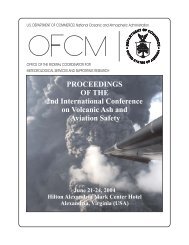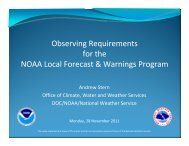Analysis of Alternatives
Analysis of Alternatives
Analysis of Alternatives
You also want an ePaper? Increase the reach of your titles
YUMPU automatically turns print PDFs into web optimized ePapers that Google loves.
This Briefing is Classified<br />
UNCLASSIFIED<br />
<strong>Analysis</strong> <strong>of</strong> <strong>Alternatives</strong><br />
(AoA)<br />
Brian Lihani<br />
Deputy Chief, Aerospace Warning Branch<br />
HQ NORAD/J35W<br />
11 May 2011
Purpose <strong>of</strong> <strong>Analysis</strong> <strong>of</strong> <strong>Alternatives</strong> (AoA)<br />
• Evaluate performance, operational effectiveness,<br />
operational suitability, and estimated costs <strong>of</strong> alternative<br />
systems to meet a mission capability<br />
• Assess advantages and disadvantages <strong>of</strong> alternatives<br />
being considered to satisfy capabilities. Includes<br />
sensitivity <strong>of</strong> each alternative to possible changes in key<br />
assumptions or variables<br />
• A key input to defining system capabilities in the<br />
Capability Development Document<br />
Bottom line<br />
Conduct analysis to determine the best solution<br />
based on cost, risk, and capability<br />
2
UNCLASSIFIED<br />
What determines an AoA is required?<br />
• DoDI 5000.02 implies that AoAs are mandatory for all<br />
programs<br />
• In reality, the true driver is statutory requirements where<br />
AoAs are mandatory for:<br />
• All potential and designated Acquisition Category (ACAT) I<br />
efforts<br />
• ACAT-I: Major Defense Acquisition Program (MDAP)<br />
• 10 USC § 2366a & b: Milestone Certifications to Congress<br />
• ACAT-IA: Major Automated Information System (MAIS)<br />
• 40 USC § 1401 et seq.: Clinger-Cohen Act (CCA) <strong>of</strong> 1996<br />
• PL 107-248 § 8808: CCA Compliance & MAIS Funding<br />
• Can be designated ACAT I / IA if “JROC Interest” – for programs<br />
where the capabilities have a significant impact on joint<br />
warfighting or have a potential impact across Services<br />
UNCLASSIFIED<br />
3
UNCLASSIFIED<br />
AoA Defined<br />
• An AoA is the evaluation <strong>of</strong> the performance, operational<br />
effectiveness, operational suitability, and estimated<br />
costs <strong>of</strong> alternative systems to meet a mission<br />
capability. (CJCSI 3170.01)<br />
UNCLASSIFIED<br />
Which one, in what configuration… or is it a combination<br />
(i.e., system <strong>of</strong> systems [SoS] or Family <strong>of</strong> Systems [FoS])?<br />
4
• Key AoA components<br />
• Operational environment<br />
• i.e., threats and scenarios<br />
• Alternative development<br />
• Employment concept development<br />
• Risk analysis<br />
• Effectiveness analysis<br />
• Cost analysis<br />
Calendar<br />
Driven<br />
• Cost-effectiveness analysis<br />
• Value to the decision process<br />
What is an AoA?<br />
• Identifies the viable trade space (not just the 100% solution)<br />
• Creates audit trail <strong>of</strong> the analysis process<br />
Joint<br />
Capabilities Integration<br />
& Development<br />
System (JCIDS)<br />
VCJCS or<br />
Service Chief Oversight<br />
ANALYSIS<br />
Planning,<br />
Programming,<br />
Budgeting & Joint CONOPS<br />
Execution (PPBE) Process<br />
DEPSECDEF<br />
Oversight<br />
UNCLASSIFIED<br />
Need<br />
Driven<br />
Defense<br />
Acquisition<br />
System<br />
MDA<br />
Oversight<br />
Event<br />
Driven<br />
• Provides an analytical basis for any acquisitions that may<br />
follow<br />
5<br />
UNCLASSIFIED
When are AoAs performed?<br />
• Suggested by an Initial Capabilities Document (ICD)<br />
• Authorized at the Material Development Decision (MDD)<br />
• Conducted during the Materiel Solution <strong>Analysis</strong> (MSA) phase<br />
• Updated prior to Milestones B and C as directed by MDA<br />
Concept<br />
Development<br />
(AFI 10-601)<br />
AoA<br />
Defense Acquisition<br />
Management System<br />
(DODI 5000-02)<br />
Initial<br />
Capability<br />
Document<br />
Development<br />
Planning &<br />
MDD<br />
Prep<br />
AoA Study<br />
Guidance and<br />
Study Plan<br />
Materiel<br />
Solution<br />
<strong>Analysis</strong><br />
Technology<br />
Development<br />
Strategy<br />
Technology<br />
Development<br />
Capability<br />
Development<br />
Document<br />
Engineering and<br />
Manufacturing<br />
Development<br />
MDD MS A MS B MS C<br />
Capability<br />
Production<br />
Document<br />
Production<br />
and<br />
Deployment<br />
Operations<br />
and<br />
Support<br />
Required<br />
Documentation
• Short answer: it depends!<br />
• Key Drivers:<br />
• Decision maker expectations<br />
How long do AoAs take and cost?<br />
• Available resources: time, personnel/expertise,<br />
funding<br />
• Data for 27 AoAs (2000-2008) **<br />
• Average cost $3.9M<br />
• Gov’t salaries not included<br />
• Earlier AoA costs very suspect<br />
• Primary factors affecting cost:<br />
• Blue Suit vs Contractor mix<br />
• Non-AoA work counted in the<br />
total (engineering design, test,<br />
etc.)<br />
• Length <strong>of</strong> the AoA (consistent<br />
$300-400K/mo)<br />
• Costs are approximate; <strong>of</strong>ten the<br />
study lead reluctant to give us<br />
costs<br />
Cheap<br />
Good<br />
Study Results<br />
“Trade Space”<br />
Fast<br />
UNCLASSIFIED<br />
• Data for 56 AoAs **<br />
• Average length 20 months<br />
• 61% took between 13-24 months<br />
• Variations generally correlate to<br />
• Complexity <strong>of</strong> the problem<br />
• Stakeholder politics<br />
• Funding levels<br />
• How much analysis already done<br />
• Times are approximate, slightly<br />
conservative<br />
• Those longer than 36 months have<br />
extenuating circumstances<br />
UNCLASSIFIED<br />
“Good, fast, or cheap… pick two!”<br />
** Data provided by OAS<br />
7
UNCLASSIFIED<br />
Cost <strong>of</strong> AoA<br />
• 2000-present: cost range from $500K to $11.5M (Ground<br />
Moving-Target Indicator (GMTI)<br />
• GMTI estimated cost was $25M – provided by Cost lead<br />
• 3600 funding only – money requested by Space and Missile<br />
Center (SMC) to directly fund work<br />
• 3400 funding and/or “in-house” contractor support<br />
• Prompt Global Strike (PGS) AoA<br />
• Pre-AoA prior to 2003 – all work “out <strong>of</strong> hide” funded<br />
• ADM assigned<br />
• Reported to AFROCC 2008; Final Report signed in 2009<br />
• Requested analysis continues<br />
** Single country, single component, single service, single MAJCOM, single<br />
mission, single technology<br />
UNCLASSIFIED<br />
8
UNCLASSIFIED/FOUO<br />
North American Air Domain Awareness –<br />
Surveillance <strong>Analysis</strong> <strong>of</strong> <strong>Alternatives</strong><br />
• Documents required for AoA start:<br />
• Joint Integrated Air & Missile Defense Organization<br />
(JIAMDO) IAMD Initial Capabilities Document (ICD)<br />
• Approved by JROCM dated 29 Oct 2010<br />
• OSD/CA&PE for AoA Study Guidance<br />
• N-NC/J58 working comments<br />
• N-NC/J5 Study Plan<br />
• Currently on hold – awaiting Study Guidance<br />
finalization<br />
• Material Development Decision (MDD) – formal entry point into<br />
acquisition process<br />
• AoA required for ACAT 1 acquisitions (DoDI 5000.02)<br />
• Purpose:<br />
• Develop an International/Interagency solution to<br />
address North American air/cruise missile surveillance<br />
gaps and deterioration while maintaining current<br />
capabilities<br />
• Scope:<br />
• AoA is unique due to scope – current planning has<br />
N-NC & ACC as co-leads<br />
• Timeline/Funding:<br />
• Currently advertised as 18-24 months after approval;<br />
$5M<br />
• N-NC/J84 supporting as follows:<br />
• Effectiveness <strong>Analysis</strong> Team Lead, Risk Team Lead,<br />
Integrating Analyst<br />
UNCLASSIFIED/FOUO<br />
Etc…<br />
7. Package Results<br />
• Focus on issues<br />
• Make it clear and understandable<br />
• Orient to decision maker<br />
• Socialize the results and get approval<br />
6. Prove the Answer<br />
• Recheck assumptions<br />
• Analyze sensitivities<br />
• Identify additional analysis needed<br />
5. Interpret the Results<br />
• Determine meaning <strong>of</strong> the data<br />
generated<br />
• Get independent sanity check<br />
4. Execute <strong>Analysis</strong> Plan<br />
Conduct the analysis<br />
• Effectiveness<br />
• Cost<br />
• Risk<br />
• Affordability<br />
AoA Activities<br />
1. Define the Problem (J58)<br />
• Determine purpose<br />
• Determine/discuss issues<br />
• Define alternatives/approaches<br />
• Determine audience for results<br />
• Identify potential detractors<br />
2. Develop <strong>Analysis</strong> Plan<br />
• Review existing knowledge<br />
• Develop appropriate<br />
measures<br />
• Develop analysis<br />
methodologies<br />
• Socialize the plan and get<br />
approval<br />
3. Gather & Review Data<br />
• Identify input data Data Types<br />
requirements • Scenarios<br />
• Accredit/certify • Tools<br />
• Identify voids • Performance<br />
• Cost<br />
9


